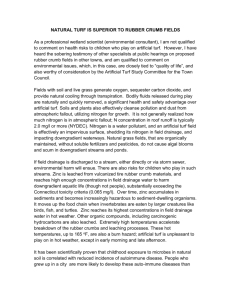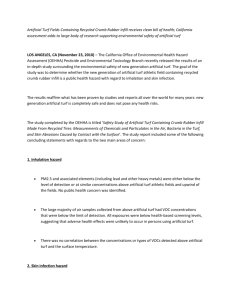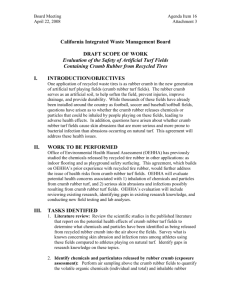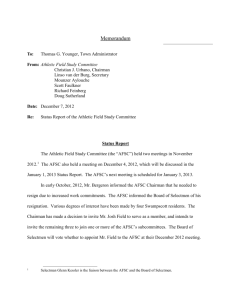artificial turf fields – aN EMERGING URBAN stormwater issue
advertisement
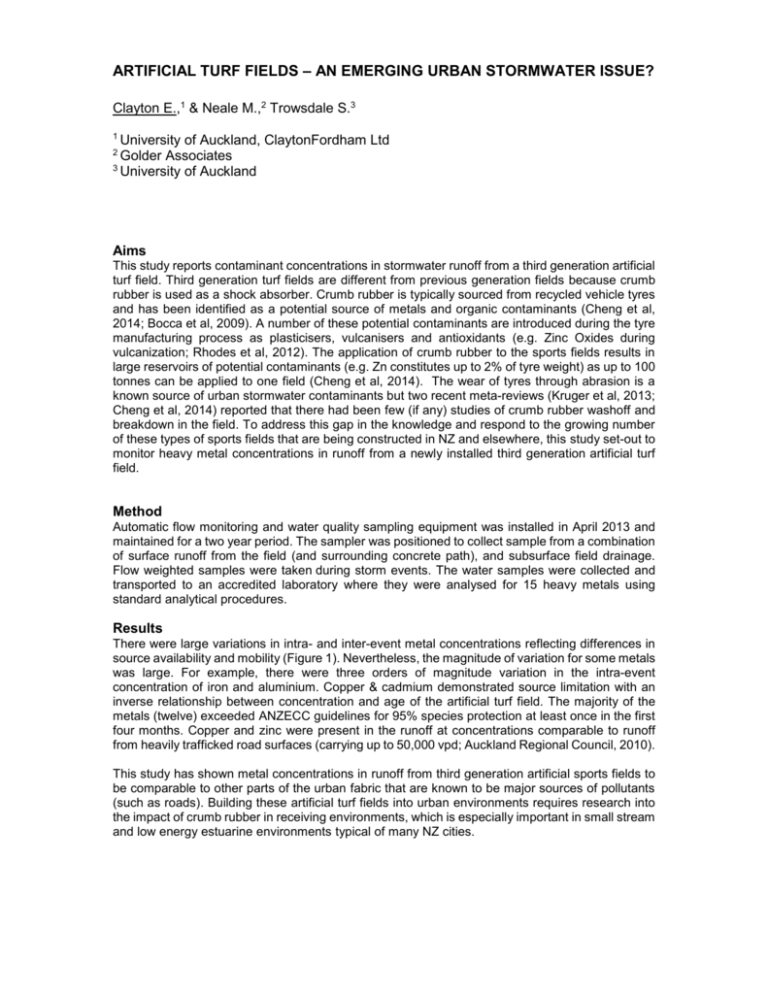
ARTIFICIAL TURF FIELDS – AN EMERGING URBAN STORMWATER ISSUE? Clayton E.,1 & Neale M.,2 Trowsdale S.3 1 University of Auckland, ClaytonFordham Ltd Golder Associates 3 University of Auckland 2 Aims This study reports contaminant concentrations in stormwater runoff from a third generation artificial turf field. Third generation turf fields are different from previous generation fields because crumb rubber is used as a shock absorber. Crumb rubber is typically sourced from recycled vehicle tyres and has been identified as a potential source of metals and organic contaminants (Cheng et al, 2014; Bocca et al, 2009). A number of these potential contaminants are introduced during the tyre manufacturing process as plasticisers, vulcanisers and antioxidants (e.g. Zinc Oxides during vulcanization; Rhodes et al, 2012). The application of crumb rubber to the sports fields results in large reservoirs of potential contaminants (e.g. Zn constitutes up to 2% of tyre weight) as up to 100 tonnes can be applied to one field (Cheng et al, 2014). The wear of tyres through abrasion is a known source of urban stormwater contaminants but two recent meta-reviews (Kruger et al, 2013; Cheng et al, 2014) reported that there had been few (if any) studies of crumb rubber washoff and breakdown in the field. To address this gap in the knowledge and respond to the growing number of these types of sports fields that are being constructed in NZ and elsewhere, this study set-out to monitor heavy metal concentrations in runoff from a newly installed third generation artificial turf field. Method Automatic flow monitoring and water quality sampling equipment was installed in April 2013 and maintained for a two year period. The sampler was positioned to collect sample from a combination of surface runoff from the field (and surrounding concrete path), and subsurface field drainage. Flow weighted samples were taken during storm events. The water samples were collected and transported to an accredited laboratory where they were analysed for 15 heavy metals using standard analytical procedures. Results There were large variations in intra- and inter-event metal concentrations reflecting differences in source availability and mobility (Figure 1). Nevertheless, the magnitude of variation for some metals was large. For example, there were three orders of magnitude variation in the intra-event concentration of iron and aluminium. Copper & cadmium demonstrated source limitation with an inverse relationship between concentration and age of the artificial turf field. The majority of the metals (twelve) exceeded ANZECC guidelines for 95% species protection at least once in the first four months. Copper and zinc were present in the runoff at concentrations comparable to runoff from heavily trafficked road surfaces (carrying up to 50,000 vpd; Auckland Regional Council, 2010). This study has shown metal concentrations in runoff from third generation artificial sports fields to be comparable to other parts of the urban fabric that are known to be major sources of pollutants (such as roads). Building these artificial turf fields into urban environments requires research into the impact of crumb rubber in receiving environments, which is especially important in small stream and low energy estuarine environments typical of many NZ cities. Metal concentrations (first four months) 1000 100 Concentration (µg/L) 10 1 0.1 0.01 0.001 0.0001 0.00001 0.000001 Al As B Cd Cr Co Cu Fe Pb Mn Hg Ni Se Zn Metal Figure 1. Metal concentrations in runoff from third generation artificial sports fields (four months of sampling) References Auckland Regional Council (2010) Contaminant Load Model User’s Manual. Auckland Regional Council Technical Report TR2010/003 Bocca, B., Forte., G., Petrucci, F., Costantini, S. & Izzo, P. (2009) Metals contained and leached from rubber granulates used in synthetic turf areas. Science of the Total Environment, 407, 2183-2190. Cheng, H., Hu, Y. & Reinhard, M. (2014) Environmental and Health Impacts of Artificial Turf: A Review. Environmental Science and Technology, 48 (4), 2114–2129. Kruger, O., Kalbe, U., Richter E., Egeler P., Rombke J. & Berger W. (2013) New approach to the ecotoxicological risk assessment of artificial outdoor sporting grounds. Environmental Pollution, 175, 6974. Rhodes, E.P., Ren, Z. & Mays, D.C. (2012) Zinc Leaching from Tire Crumb Rubber. Environmental Science & Technology, 46, 12856-12863.
